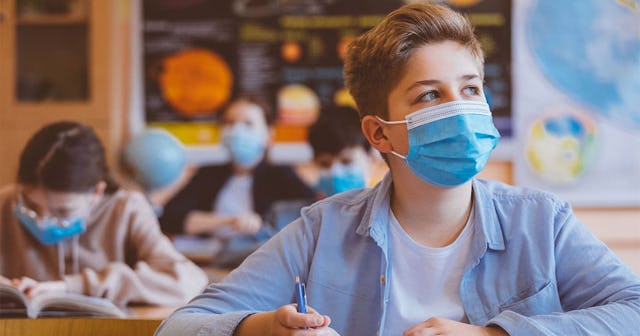CDC Issues Face Mask Guidance For Schools

The CDC has just released new guidelines pertaining to cloth face masks in school, and they address face mask bullying
As if you weren’t already spinning out over schools reopening, the Centers for Disease Control (CDC) has added a concern you perhaps hadn’t considered yet: face mask bullies. On Tuesday, the organization issued new guidelines via its website centered on issues specific to wearing face masks when classes resume. Much of the recommendations reiterate information we’re all familiar with by now, i.e hand washing and social distancing. But the CDC also addresses the “unintended consequences” of students wearing face masks.
To be clear, the new guidelines contain very useful information for parents, students, and school administrators. The gist? Everyone should have a plan firmly in place that encourages behavior that might stem the spread of COVID-19 in schools — with a specific emphasis on wearing a face mask. “The use of cloth face coverings is especially important when social distancing is difficult to maintain,” the CDC explains.
They continue, “Cloth face coverings are recommended as a simple barrier to help prevent respiratory droplets from traveling into the air and onto other people when the person wearing the cloth face-covering coughs, sneezes, talks, or raises their voice.” And, let’s be real, kids do all of those things… a lot. So, this suggestion makes sense. However, the CDC is also realistic that getting kids to wear face masks “may present challenges” and “unintended consequences.”
Challenges, we get. What are these consequences, though? “Stigma, discrimination, or bullying may arise due to wearing or not wearing a cloth face covering,” the CDC explains. “Schools should have a plan to prevent and address harmful or inappropriate behavior.” This includes being aware that it may not just be children who push back. “Not all families will agree with school policies about cloth face coverings. Schools should have a plan to address challenges that may arise and refer parents, caregivers, and guardians to CDC’s guidance on cloth face coverings,” the site says.
The organization also points out that consideration should be given for other special circumstances, such as when a student is deaf or hard of hearing (or relies on lip-reading to communicate). In such instances, clear face coverings may be necessary for teachers and others who interact with the student on a regular basis.
If you have children in different age groups, you may be wondering if the guidelines vary at all. Well, the core recommendations — underscoring the importance of hand-washing, staying six-feet apart, etc. — are basically universal. The CDC does break down their suggestions further, though, addressing elementary school, middle school, high school, and special needs settings.
https://twitter.com/jetpack/status/1293489795541467140
So, for example, elementary school students will need adults to help them put on and adjust their face coverings or properly wash their hands. Middle school students can be reminded how to do these things via short-form videos (you could probably ask your kids for TikTok recommendations, amirite?).
For the full and very comprehensive rundown, you can visit the CDC website. And remember, we’re all figuring this out together. It’s probably going to be a shit show at first, but you aren’t in it alone. See also: Don’t be the “angry parent” railing about face masks and making the “unintended consequences” section of the CDC’s new guidelines a troubling reality. 2020 has already met its Karen quota.
This article was originally published on